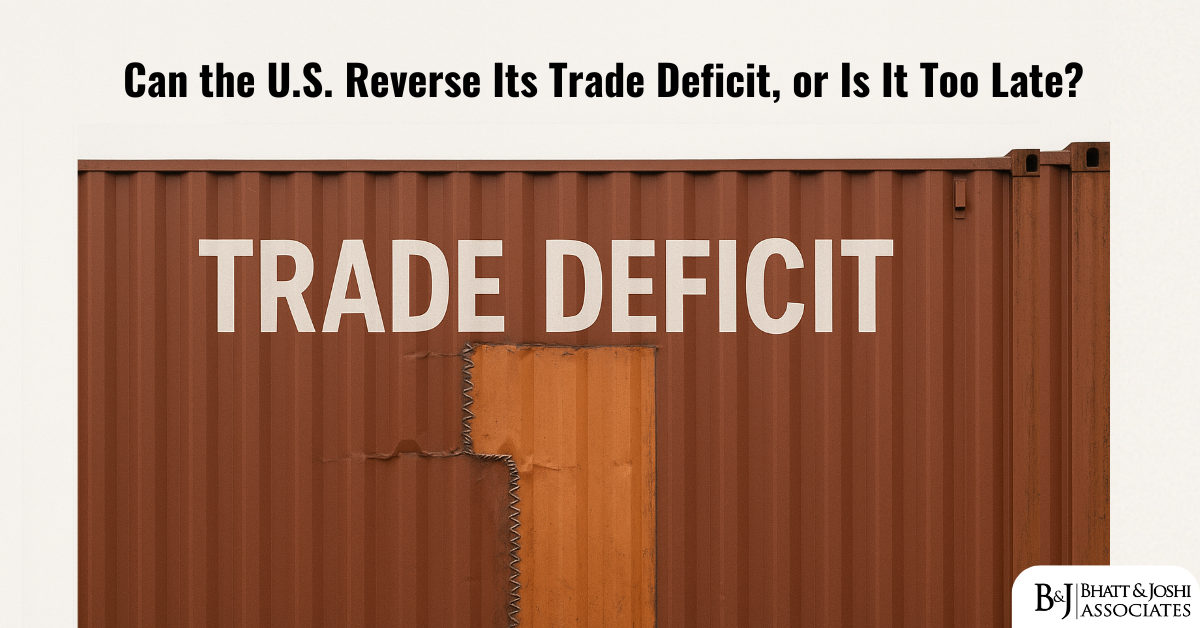Introduction
The United States trade deficit has reached unprecedented levels, exceeding $1 trillion annually and raising fundamental questions about the sustainability of current economic patterns. This persistent imbalance represents more than just a statistical concern; it reflects deep structural changes in the American economy and its place in the global economic order. As policymakers and economists debate whether and how this deficit can be reversed, the question becomes increasingly urgent: has America passed a point of no return, or can decisive action still lead to U.S. trade deficit reduction and rebalance its international trade position?
This challenge extends beyond simple economics into questions of national security, technological leadership, and future prosperity. Understanding whether the trade deficit can be meaningfully reduced requires examining both historical precedents and current economic realities, while considering the complex interplay of domestic and international factors that shape trade patterns.
Understanding the Scale of the U.S. Trade Deficit
The current trade deficit represents a challenge unprecedented in both scale and complexity. The deficit has grown from occasional imbalances in the 1970s to a structural feature of the American economy, now regularly exceeding 3% of GDP. This growth reflects fundamental changes in global economic relationships, manufacturing patterns, and consumption habits that have developed over decades.
Beyond its sheer size, the deficit’s composition has evolved significantly. While earlier deficits often reflected primarily oil imports or trade with advanced economies, today’s deficit encompasses a broad range of manufactured goods and increasingly involves technology and services. This transformation makes traditional solutions less effective and requires more comprehensive approaches to address the imbalance.
The U.S. Trade Deficit: A Historical Overview
The United States has not always run trade deficits. In the decades following World War II, America consistently maintained trade surpluses, supported by unrivaled industrial capacity and technological leadership. The transition to persistent deficits began in the 1970s, accelerated in the 1980s with the rise of Japan and Germany, and reached new levels with China’s economic emergence.
This historical progression reveals important lessons about how trade positions can change and what factors drive such changes. The experience of other countries, particularly Germany and Japan in managing their trade relationships, provides valuable insights into possible approaches to U.S. trade deficit reduction.
Past Reform Attempts
Previous efforts to address the trade deficit have produced mixed results. The Plaza Accord of 1985, which coordinated international action to devalue the dollar, provided temporary relief but failed to address underlying structural issues. Various “Buy American” initiatives and domestic content requirements have similarly shown limited effectiveness in significantly reducing the deficit.
The limitation of past efforts often stemmed from treating symptoms rather than causes. Currency adjustments, trade restrictions, and export promotion programs, while sometimes helpful, failed to address deeper structural issues in the American economy that contribute to persistent deficits.
Structural Challenges in U.S. Trade Deficit Reduction
Several structural factors make deficit reduction particularly challenging:
The dollar’s role as global reserve currency maintains its high value, making exports less competitive while keeping imports relatively cheap. The U.S. economy’s orientation toward consumption rather than production, supported by relatively low savings rates, creates persistent import demand. The erosion of manufacturing capabilities and supporting infrastructure makes it difficult to quickly expand domestic production.
These structural issues suggest that any successful effort to achieve U.S. trade deficit reduction must address deeper economic patterns, not just surface-level trade policies.
Policy Options for U.S. Trade Deficit Reduction
Contemporary approaches to deficit reduction encompass several strategies:
Industrial policy initiatives aim to rebuild domestic manufacturing capabilities in strategic sectors. The CHIPS Act represents a significant example of this approach, providing substantial support for semiconductor production. Supply chain resilience programs seek to reduce dependence on foreign suppliers while creating domestic alternatives.
These efforts recognize that addressing the trade deficit requires comprehensive policy responses rather than isolated trade measures.
The Reshoring Question
The potential for reshoring manufacturing represents a crucial element in deficit reduction strategies. However, the challenges and costs of rebuilding domestic production capabilities are substantial. Success requires addressing several key issues:
Workforce development to provide needed skills and expertise. Infrastructure investment to support modern manufacturing. Supply chain development to provide necessary components and materials. Innovation support to maintain competitive advantages.
Role of Technology in Trade Deficit Reduction
Technology and innovation policy plays an increasingly important role in trade deficit reduction efforts. Leadership in emerging technologies like artificial intelligence, quantum computing, and renewable energy could create new areas of comparative advantage for American industry.
However, maintaining technological leadership requires sustained investment in research and development, education, and supporting infrastructure. The connection between innovation capabilities and trade performance has become increasingly direct and crucial.
International Cooperation
Addressing the trade deficit requires engaging with international partners to create more balanced trading relationships. This involves:
Negotiating new trade agreements that better protect American interests. Coordinating with allies on approaches to common challenges like China’s trade practices. Developing international standards and rules that support fair competition.
Success requires finding ways to pursue American interests while maintaining beneficial international economic relationships.
Future Scenarios for U.S. Trade Deficit
Several possible scenarios could emerge from current efforts to address the trade deficit:
Gradual Rebalancing: Sustained policy efforts could slowly reduce the deficit through manufacturing revival and export growth. Partial Decoupling: Strategic sectors might see significant reshoring while other areas maintain current patterns. Regional Realignment: Trade patterns could shift toward closer allies and partners without necessarily reducing overall deficits.
Conclusion
The question of whether the United States can reverse its trade deficit does not have a simple answer. While complete elimination of the deficit may be neither possible nor desirable, significant reduction appears achievable with sustained, comprehensive policy effort.
Success will require addressing both immediate trade issues and deeper structural challenges in the American economy. This includes rebuilding manufacturing capabilities, investing in innovation, developing workforce skills, and creating more balanced international economic relationships.
The path forward likely involves a combination of approaches:
- Strategic industrial policy in key sectors
- Investment in innovation and infrastructure
- Workforce development and education
- International cooperation with allies
- Careful management of key trading relationships
While it may be too late to return to the trade surpluses of the post-war era, it is not too late to create a more balanced and sustainable trade position. The key lies in recognizing that trade deficits reflect broader economic patterns and require comprehensive solutions rather than simple trade policy adjustments.
The future of American trade balance will depend on the nation’s ability to adapt to changing global economic realities while rebuilding domestic capabilities and maintaining international competitiveness. This challenge, while significant, is not insurmountable with proper policy focus and sustained commitment to economic renewal.














